Master of Clinical Exercise Physiology 2013
advertisement
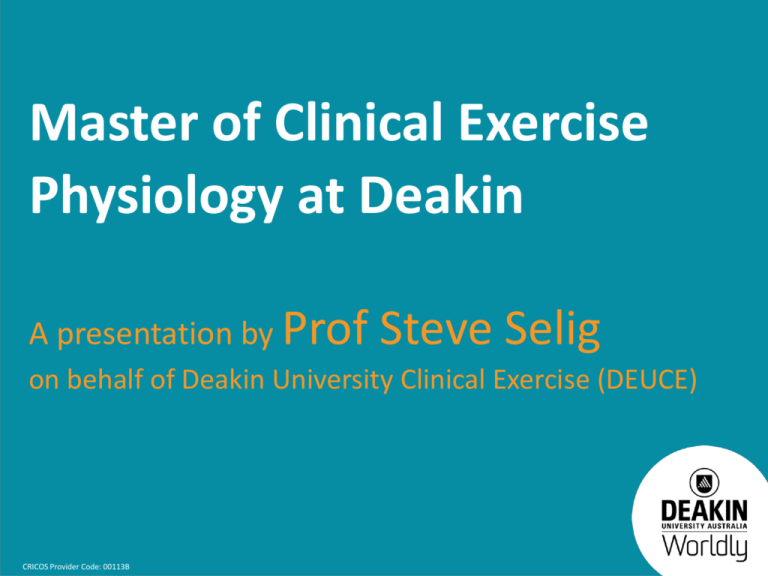
Master of Clinical Exercise Physiology at Deakin A presentation by Prof Steve Selig on behalf of Deakin University Clinical Exercise (DEUCE) CRICOS Provider Code: 00113B Deakin University Clinical Exercise (DEUCE) Members of DEUCE: Prof Steve Selig, AEP, PhD Dr Steve Fraser, AEP, PhD Dr Natalie Saunders, AEP, PhD Dr Dawson Kidgell, PhD Dr Andrew Dawson, PhD Ms Karen Salter, AEP, M.Appl.Sci- Ex Rehab Ms Niamh Mundell, AEP, M.Appl.Sci- Ex Rehab Ms Unna Goldsworthy, AEP, Grad Dip – Ex Rehab Ms Helen Donovan, BSc – Psych, Grad Dip - Psych CRICOS Provider Code: 00113B OVERVIEW • • • • • • Course Structure How to Apply What do AEPs do? Careers as an AEP Compensable Schemes available to AEPs More information CRICOS Provider Code: 00113B H743 COURSE STRUCTURE Trimester 1 HSE703 Exercise Behaviour and Motivation HSE705 Exercise Physiology for Cardiopulmonary Disease HSE707 Exercise Physiology for Musculoskeletal Injury and Disease HSE711 Pre Clinical Practice 1 Trimester 2 HSE702 Exercise Physiology for Neurological and Neuromuscular Disease HSE704 Exercise Physiology for Metabolic Disease HSE712 Pre Clinical Practice 2 HSE714 Clinical Practicum 1 CRICOS Provider Code: 00113B H743 COURSE STRUCTURE CONTINUED Trimester 3 HBS745 Interprofessional Collaboration in Health Care HSE709 Exercise Physiology for Special Populations HSE715 Clinical Practicum 2 HSE717 Clinical Practicum 3 Notes on practicum: 1.Applicants for the Masters MUST have completed 140 hours of exercise service delivery for apparently healthy clientele PRIOR to application for entry. 2.All the remaining clinical practicum is included in the course structure and so graduates will be eligible to apply for AEP accreditation on graduation. CRICOS Provider Code: 00113B STRONG TRANSITION FROM CLINICAL EXERCISE SCIENCE TO CLINICAL EXERCISE PRACTICE TO WORK Stage of Course Emphasis of Course Trimester 1 Knowledge Clinical Exercise Sciences Pre-Clinical Practice gain knowledge reinforce, refresh and apply knowledge Musculoskeletal Cardiopulmonary Pre-Clinical 1 Exercise Behaviour Trimester 2 Early Application Clinical Exercise Investigations Partial case studies: clinical ex presc reinforce, refresh and apply knowledge Core Graduate Attributes map strongly with this approach Professional Skills practise clinical skills under supervision Clinical Exercise Services Complete case studies reinforce, refresh and apply knowledge Neurological Metabolic Pre-Clinical 2 Clinical 1 Trimester 3 * Clinical 1 * Clinical 2 mentored clinical practice Trimester 1, Yr 2 Work Readiness Clinical Exercise Practice Capstone task Special Populations Interprofessional Learning Clinical 2 Clinical 3: Capstone Tasks graduation Novice Practitioner Practice and Work * Masters Clinical Exercise: 4 Trimesters including a T3 (summer trimester) that is used primarily for clinical placements AIMS OF THE MASTER OF CLINICAL EXERCISE PHYSIOLOGY All graduates of the Masters will: • possess the necessary knowledge, competencies and clinical experience to become an AEP • be able to deliver safe and effective exercise services for clientele with chronic conditions and injuries; • understand the effects of acute and chronic exercise for people with chronic medical conditions and complex care needs; • engage with the profession through ESSA and other professional activities • have developed skills and habits for lifelong independent learning to enable them to continue to develop as practitioners CRICOS Provider Code: 00113B HOW TO APPLY Entry Criteria: a. Graduate Student Member of ESSA* PLUS evidence of 140 hours of exercise service delivery for apparently healthy clientele OR b. Applicants who have graduated from an ESSA NUCAP accredited program in Exercise Science** (strict eligibility rules apply) PLUS evidence of 140 hours of exercise service delivery for apparently healthy clientele OR c. Current Exercise Scientist/Full Member of Exercise and Sports Science Australia (ESSA) PLUS evidence of 140 hours of exercise service delivery for apparently healthy clientele * ESSA has a graduate student membership category (this is not the same as the student membership category available to undergraduate students); graduate student membership will guarantee you FULL membership of ESSA after graduation from the Master of Clinical Exercise Physiology (H743) and then automatic AEP accreditation. Membership application form can be downloaded from http://www.essa.org.au/ ** Deakin University graduates of Bachelor Exercise and Sport Science (ESSA Stream) are eligible under this option CRICOS Provider Code: 00113B EXERCISE SERVICE DELIVERY FOR APPARENTLY HEALTHY CLIENTELE: APPROVED ACTIVITIES 1. 2. Screening and risk management Assessment of client a. b. c. 3. Exercise capacities Functional capacities (eg vocational / occupational, recreational, activities of daily living) Psychosocial assessments in relation to exercise and physical activity, including maintenance Planning of exercise interventions: a. b. c. d. Goal setting: client and practitioner; others (eg health professionals) Identifying barriers and facilitators for exercise and physical activity Providing solutions for barriers Designing exercise interventions CRICOS Provider Code: 00113B APPROVED ACTIVITIES CONTINUED 4. Delivery of exercise interventions: a. Teaching correct technique and coaching b. Motivation c. Self-management d. Program management: eg daily / weekly planner 5. Evaluation of exercise interventions: a. pre vs. post intervention assessments b. Practice efficacy data CRICOS Provider Code: 00113B COVER LETTER 1. Academic background, including university courses completed and grade point average (WAM, GPA, or equivalent) 2. Relevant work experience, including the roles and responsibilities undertaken 3. Statement articulating your reasons for wanting to become an Accredited Exercise Physiologist (AEP) CRICOS Provider Code: 00113B SELECTION CRITERIA 1. Satisfying the entry criteria PLUS 2. GPA, WAM (or equivalent) of Distinction average for a suitable undergraduate qualification 3. Work experience and/or other attributes that demonstrate suitability for the course and the profession of an AEP 4. Some applicants may be invited to interview prior to offers for entry into the course CRICOS Provider Code: 00113B MASTER OF CLINICAL EXERCISE: EXTERNAL ACCREDITATION • The Master of Clinical Exercise Physiology (H743) now has preliminary accreditation with the National University Course Accreditation Program (NUCAP) • We submitted our application for FULL accreditation in Dec 2011; this should be approved before you graduate • FULL accreditation will permit automatic AEP accreditation for graduates provided that • you are able to provide completed Clinical Practicum Logbooks: 140 hours cardiorespiratory / metabolic, PLUS 140 hours musculoskeletal / neuromuscular / neurological, PLUS 80 hours “other” clinical experiences PLUS 140 hours of exercise service delivery for apparently healthy clientele (latter is needed PRIOR to application for entry) CRICOS Provider Code: 00113B What does the accredited exercise physiologist (AEP) do? The AEP uses exercise “therapy” to improve clients’: 1. Clinical status (through 10 and 2o prevention, and rehabilitation) 2. Functional status (eg ADLs, fitness) 3. Psychosocial status (anxiety and symptoms of depression, quality of life) EBP is the cornerstone CRICOS Provider Code: 00113B Why is exercise therapy needed in Australia? and the developed and developing world? CRICOS Provider Code: 00113B Exercise is medicine ….. 1. Medicare Australia (and other national health systems) will be bankrupted by the burden of chronic disease if lifestyle medicine does not supplement conventional medicine. 2. Lifestyle medicine $$ compared to conventional medicine 3. Exercise is a “poly-pill” obesity, insulin sensy, lipids, blood pressure, anxiety + depression, mortality 4. No client ever wants to take another pill or have another operation DREAM OUTCOMES FOR THE AEP Category Outcome Clinical Status disease progression risk factors medications +/- doses risk of new diagnosis hospitalisations knowledge of condition, motivation, self-management Function (fitness) Long term “healthy addiction” to exercise injured worker rehabilitation independent living Return to sport outcomes Quality of life medications +/- doses (anti-depressants, sleep) risk of depression CRICOS Provider Code: 00113B TARGET PATHOLOGIES > 1% PREVALENCE IN AUSTRALIA AND EVIDENCE BASE FOR EXERCISE THERAPY Category Condition Cardiopulmonary Hypertension (HT), coronary artery disease (CAD), peripheral vascular disease (PVD), myocardial infarction AMI), chronic heart failure (CHF), asthma, COPD, cystic fibrosis (CF) Metabolic Obesity, dyslipidaemias, impaired glucose tolerance (IGT), diabetes mellitis (DM) Musculoskeletal Arthritides (esp. OA and RA), osteoporosis (OP), subacute and chronic specific and non-specific musculoskeletal pain / injuries, surgery, epicondylitis, tendinopathies Neurological / Neuromuscular Stroke (CVA), spinal cord injury (SCI), acquired brain injury (ABI), Parkinson’s Disease, Multiple Sclerosis (MS) Other Cancers, Depression The list is not meant to be exhaustive: AEPs are accredited on competencies for these, but practise also in other pathologies (e.g. CFS) CRICOS Provider Code: 00113B What are some differences between AEPs and physiotherapists? Physiotherapists treat the primary problem, usually an injury, at the acute and early post-acute stages of rehabilitation. AEPs treat the whole person, using exercise and other lifestyle strategies including health coaching. AEPs help people recovering from illness (eg heart attack), injury (soft tissue) or an operation (eg hip replacement), with a goal to helping clients to help themselves to better long term health and fitness (prevention). CRICOS Provider Code: 00113B Do AEPs earn the same as physiotherapists? • Yes, when these health professionals are employed by hospitals. • Both enter their professions at Grade I, with equal salary and status. They can then progress in their careers from there. • The billing charges under Medicare, WorkSafe and other compensable schemes are very comparable for physiotherapists and AEPs CRICOS Provider Code: 00113B CAREERS AS AN AEP • Hospital rehabilitation –Restoration of function and 20 prevention for in-patients and outpatients • Medical rehabilitation –10 and 20 prevention, and restoration of function for patients referred by medical practitioners • Occupational rehabilitation –Return to work programs (RTW) –Injury Prevention Work Conditioning • Community rehabilitation –10 and 20 prevention, and restoration of function for clients referred by medical practitioners/physiotherapists/ self-referred –Aged Care and Fitness facility clientele CRICOS Provider Code: 00113B CAREERS AS AN AEP CONTINUED • Sports rehabilitation –Return to training and competition for injured athletes –Injury Prevention Conditioning • Case Management –Human Resources Departments –OH&S Departments –Insurers –Decision and Policy Makers • AEP academic (universities) –AEPs who also complete a PhD in clinical exercise CRICOS Provider Code: 00113B COMPENSABLE SCHEMES AVAILABLE TO AEPS (ALL ACHIEVED SINCE 2006) • Medicare (Aust.) • WorkCover (Qld, NSW, WA, SA, ACT) / WorkSafe (Vic) • TAC • Veterans Affairs • Comcare (Commonwealth Workers Health Scheme) • Private Insurers • Others to come CRICOS Provider Code: 00113B PRIVATE HEALTH FUNDS RECOGNISE EXERCISE PHYSIOLOGY SERVICES • • • • • • AHM CBHS GMF Health Medibank Private MBF Teachers Federation Health CRICOS Provider Code: 00113B • • • • • • GU Health Australian Unity NIB HBF HCF Reserve Bank SCHOOL CAREERS’ WEBSITE www.deakin.edu.au/ens/careers CRICOS Provider Code: 00113B MORE INFORMATION FOR MASTER OF CLINICAL EXERCISE PHYSIOLOGY (H743) Professor Steve Selig (Course Director) steve.selig@deakin.edu.au 0418 570 772 Dr Steve Fraser (Deputy Course Director) steve.fraser@deakin.edu.au 9244 6012 CRICOS Provider Code: 00113B GRADUATE STUDENT MEMBERSHIP OF ESSA • Cost: $88/yr: this fee includes an assessment of your undergraduate credentials for future FULL membership of ESSA that is required in order for you to become an AEP • You do NOT need to be FULL member of ESSA whilst studying the Master of Clinical Exercise Physiology (H743). • Benefits of graduate student membership of ESSA: – – – – – enhance your CV!! access to professional network, professional indemnity insurance, ESSA magazine, journals, discounted conferences, seminars emails on current positions in exercise and Sports Science • How to register: download form www.essa.org.au • Or contact ESSA university liaison: steve.fraser@deakin.edu.au CRICOS Provider Code: 00113B
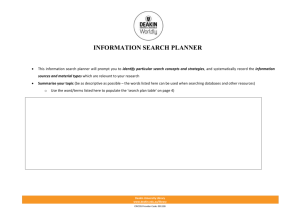
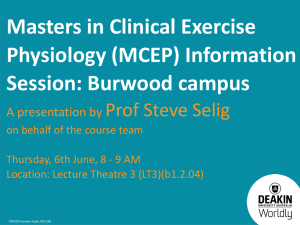
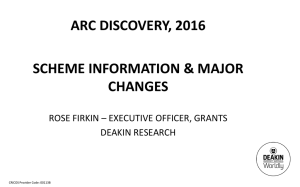
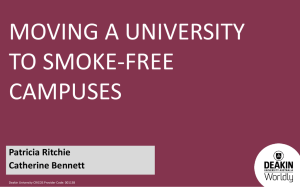
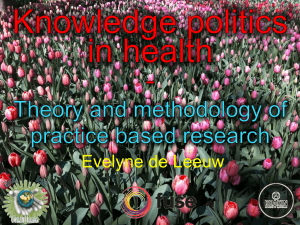
![e-Exemption, Application for []](http://s3.studylib.net/store/data/008785386_1-026ce651779c9693dde4b1ba9583a68c-300x300.png)


